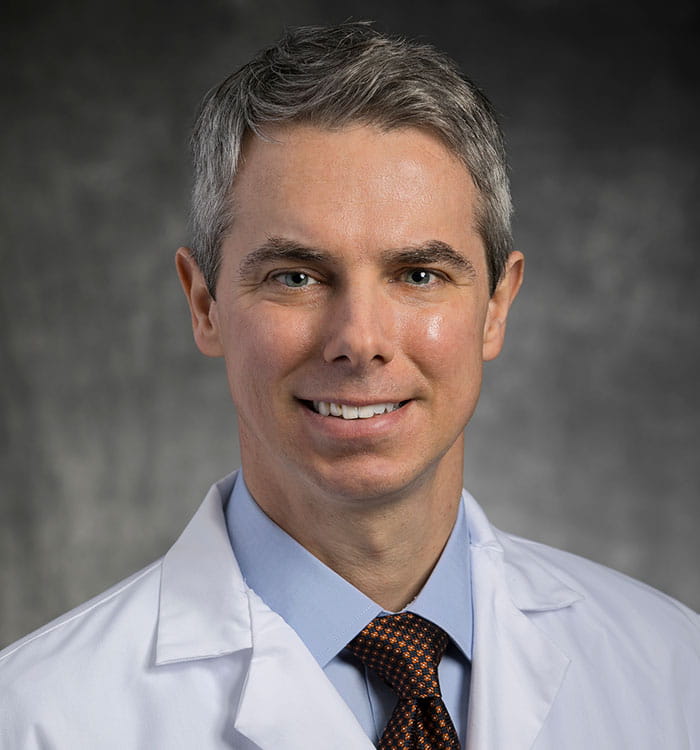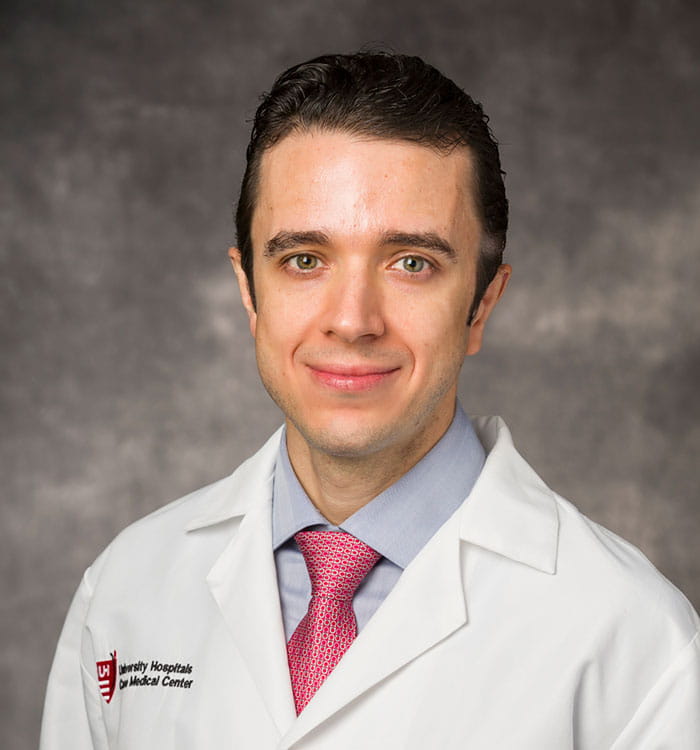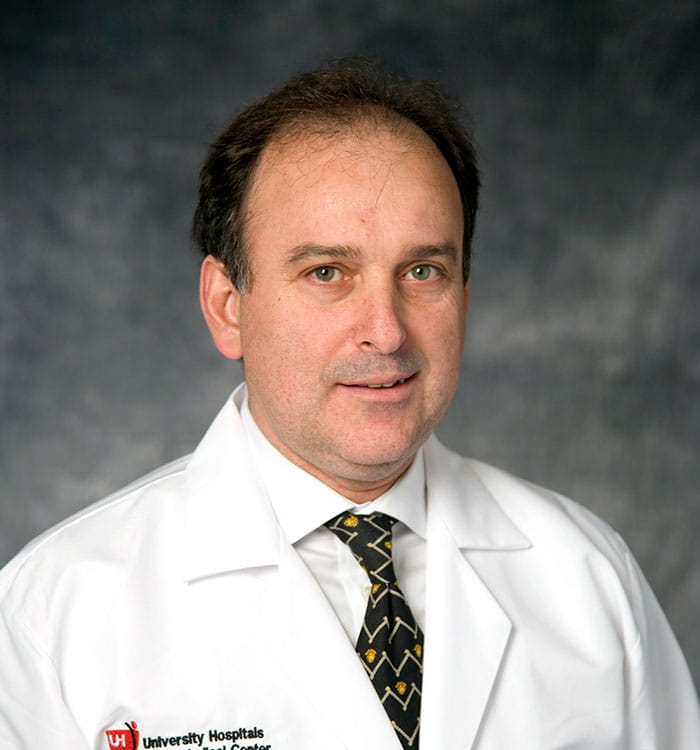Same-Day Discharge Offers Excellent Outcomes, Patient Satisfaction for Percutaneous Cardiac Procedures
July 12, 2022
Innovations in Cardiovascular Medicine & Sugery | Summer 2022
Innovative same-day discharge protocols within the Center for Advanced Heart & Vascular Care at University Hospitals Cleveland Medical Center are helping patients recover in the comfort and familiarity of home following percutaneous coronary intervention. This includes atrial fibrillation (AFib) ablation, left atrial appendage closure (LAAC) and transcatheter aortic valve replacement (TAVR).
 Steven Filby, MD
Steven Filby, MD Guilherme Attizzani, MD
Guilherme Attizzani, MD Mauricio Arruda, MD
Mauricio Arruda, MDWhile appropriately selected patients were already benefitting from same-day discharge prior to 2020, the realities of COVID-19 accelerated the need to ease hospital occupancy and reduce the risk of virus transmission.
“During the first wave of the pandemic, there was tremendous emphasis on safety and restrictions placed on elective procedures,” says Steven Filby, MD, Director of the Cardiac Catheterization Laboratory at University Hospitals Harrington Heart & Vascular Institute. “With this in the backdrop, we developed an approach to systematically evaluate patients and determine who could be sent home safely.” Eliminating overnight stays has enhanced patient satisfaction and resulted in cost containment and improved utilization of healthcare resources.
Contributing to the opportunity to reduce hospital bed demand is University Hospitals’ advanced imaging capabilities that guide procedural planning. “As we started using CT [computed tomography] for pre-planning, we found that our expertise and efficiency with these procedures enabled us to release people to home sooner,” says Guilherme Attizzani, MD, Co-Director of the Valve & Structural Heart Disease Center at UH Harrington Heart & Vascular Institute and the Alexander and Marianna McAfee Chair in Innovative Cardiac Interventions.
University Hospitals Health System was one of the first systems nationwide to co-locate imaging within the cardiac catheterization and surgical suites to provide a seamless patient experience. Another advancement reducing the need for extended post-procedural care is the use of conscious sedation, which eliminates the need for intubation.
For qualifying patients who need extra support, the Hospitals@Home program of University Hospitals provides inpatient-level care for individuals in their home environment. The novel program offers services including 24/7 remote monitoring, virtual connectivity to caregivers and in-person follow-up visits. Ongoing collaboration between the interventional cardiologists and Hospitals@Home providers ensures that post-procedural care is consistent and thorough.
AFib Ablation
Recognized as a Center of Excellence procedure, AFib ablation has been designated as a fully covered benefit within the 2022 University Hospitals employee health plan. State-of-the-art mapping and robotic navigation allow for individualized treatment for each patient. “We have the expertise and image guidance capabilities to perform these procedures while patients are arousable and breathing on their own,” says Mauricio Arruda, MD, Director of the Electrophysiology Center and Atrial Fibrillation Center at University Hospitals Harrington Heart & Vascular Institute and the John R. Antonucci Master Clinician of Cardiovascular Innovation.
“With everything we do, we work to reduce adverse effects and improve the patient experience. AFib ablation is a high-volume procedure with an excellent record here, allowing many of our patients to return home within hours of the procedure and remain free from atrial flutters for extended periods.”LAAC
Also recognized as a Center of Excellence procedure, LAAC has experienced exponential quarterly growth at UH. Dr. Filby explains that a conventional closure approach utilizes transesophageal echocardiography (TEE), which carries risk of esophageal injury. “TEE is not a benign procedure. Since shifting our protocol to cardiac CT, we can generate crisp, three-dimensional images for precise pre-planning.” The team also deploys the occluding device via intracardiac echo (ICE) catheter. He and his colleagues recently published findings from their same-day discharge program in the Journal of Invasive Cardiology. They include 100 percent success in device placement and a 15 percent cost savings compared to conventional protocols. At present, more than 90 percent of patients who undergo the procedure at UH are discharged on the same day. “We have a nurse navigator who guides patients and their families through every step of the procedure,” says Dr. Filby. “Patients are happier, and we are able to liberate resources within the hospital.”
TAVR
The Valve & Structural Heart Disease team at UH Harrington Heart & Vascular Institute was among the first in the country to pioneer minimally invasive techniques for aortic valve stenosis, eliminating the need for an open chest surgery. The replacement valve is implanted via a catheter inserted through the groin. Low-risk patients in need of aortic valve replacement are often candidates for local anesthesia and minimal sedation, reducing complications and inpatient length of stay. “We have established extensive inclusion criteria in determining what is safe and have both baseline and intraprocedural benchmarks that we require before releasing an individual,” says Dr. Attizzani. “Our partnership with Hospitals@Home provides another layer of protection because we know patients will have folks checking on them at home to ensure they are progressing well with their recovery.”
For more information, contact Dr. Arruda at Mauricio.Arruda@UHhospitals.org, Dr. Attizzani at Guilherme.Attizzani@UHhospitals.org or Dr. Filby at Steven.Filby@UHhospitals.org.
Contributing Experts:
Mauricio Arruda, MD
Director, Electrophysiology Center and Director, Atrial Fibrillation Center
University Hospitals Harrington Heart & Vascular Institute
Associate Professor
Case Western Reserve University School of Medicine
Guilherme Attizzani, MD
Co-Director, Valve and Structural Heart Disease Center
University Hospitals Harrington Heart & Vascular Institute
Associate Professor
Case Western Reserve University School of Medicine
Steven Filby, MD
Director, Cardiac Catheterization Laboratory
University Hospitals Harrington Heart & Vascular Institute
Assistant Professor
Case Western Reserve University School of Medicine


